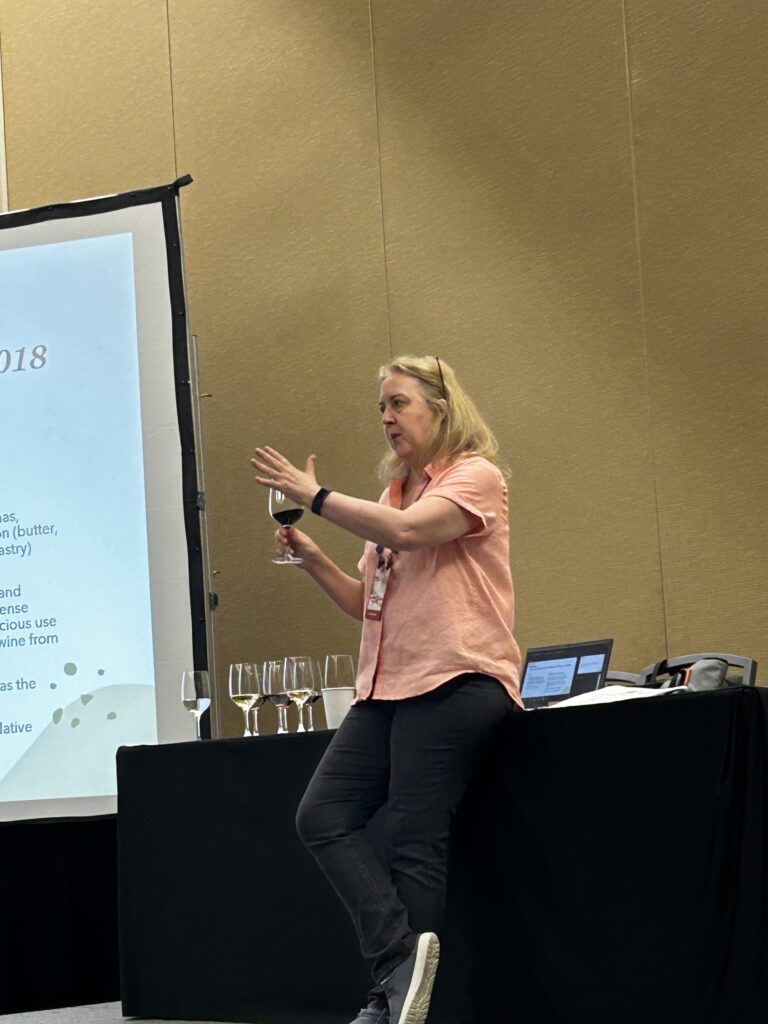
Tasting Track:
WSET versus MW
Presented by Dilek Canner, MW
Dilek Canner, a Master of Wine and the force behind the Dallas Wine Education Center and Blind Bishop in Dallas, Texas, is someone I’m always thrilled to learn from. I’ve had the pleasure of taking my WSET 2 & 3 courses with her and have even taught a few classes for the Dallas Wine Education Center. Her teaching style, refreshingly devoid of pretentiousness, aligns perfectly with her philosophy that wine should never be overly intimidating.
Now, she did make quite the bold claim during the seminar – that the Master of Wine exam is a breeze. She inists that is is all about following directions.
The seminar’s focus was a fascinating exploration of the tasting notes required for those pursuing the Wine and Spirits Educational Trust (WSET) courses compared to the standards for Master of Wine candidates. With about half of our class not engaged in WSET tasting but exploring alternative paths of wine education, Dilek simplified the comparison for us.
WSET
– Describe the wine accurately
– Offer brief conclusions about its source & quality
MW
Utilize wine descriptions and evaluations to draw informed conclusions
– Formulate mini-conclusions supported by concrete evidence derived from the glass
– Aim for a comprehensive assessment, including Variety, Origin, Style, Quality, Maturity, Vintage, Commercial Potential, and Market Insights
It’s evident that the MW standards demand significantly more, which partially explains why there are only 418 Masters of Wine globally.
Tasting as an MW revolves around meticulously assembling evidence to substantiate every single conclusion. For someone like me, whose tasting often leans on intuition, this can be quite challenging. I might taste a wine and confidently declare it’s Italian, probably Sangiovese. However, when it comes to composing a tasting note for WSET or MW, I must deconstruct the ‘why.’ MW insists that I prove my point.
So here’s the deal: the wine is red, displaying a garnet rim, high acidity, high tannins, and a medium body. I detect a prominent cherry aroma. This initially narrows down the possibilities to Sangiovese, Nebbiolo, or Tempranillo. Yet, as I scrutinize the tannins, I discern they lack the aggressiveness typical of Nebbiolo. Upon a more profound inhalation, notes of tomato leaf, leather, and a hint of florals emerge, effectively ruling out Tempranillo. Each element must be substantiated beyond any reasonable doubt.
I engage in lateral tastings and categorize wines into clusters. I group flavors systematically. If, for instance, I encounter roses and tropical fruit notes in a white wine, I’m inclined to think Gewürztraminer, unless the acidity is remarkably high. However, once I detect those floral nuances, my list of potential varietals shrinks to Gewürztraminer, Torrontes, or Muscat, generally speaking.
Dilek Canner highlighted some of the most common tasting pitfalls, such as ignoring laterals. If you’re certain, why are you? Disproving those lateral possibilities is crucial. Another common error is jotting down everything you know about a specific wine – but that’s not the task at hand. You’re tasked with crafting a tasting note exclusively based on the wine before you.
I’m going to go pop a bottle of wine and uncover more lateral avenues.
